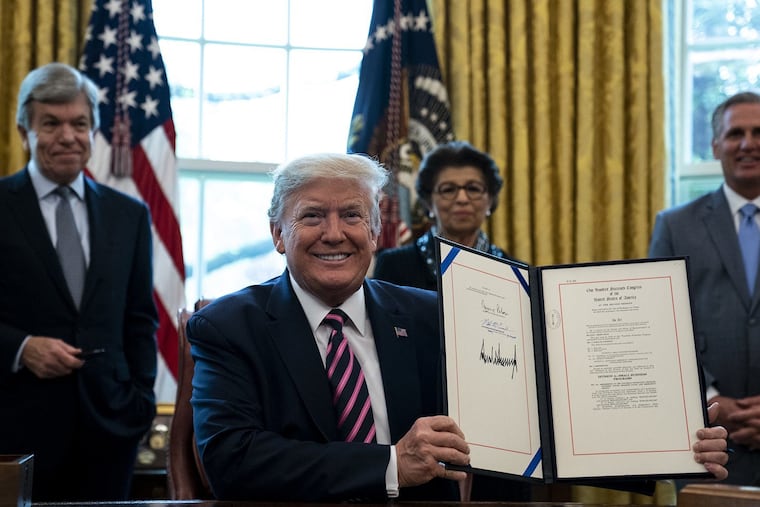Banker says Trump’s PPP loans saved American business, and they’re back under Biden
Banks begin accepting applications for forgiveable loans this week from the Paycheck Protection Program.

Banks that give out forgivable loans from the federal Paycheck Protection Program (PPP) start taking applications this week from businesses and other employers, for the $147 billion in new funds approved by Congress and President Trump, plus leftover money from last year’s program.
“We’ll go live with more PPP loans” this week, said Vernon Hill, chairman of Philadelphia-based Republic Bank, which lent more than $700 million under the original program and its summer extension.
“We are not seeing the rush we saw last time,” said Chad Palank, Regional Manager for Business and Professional Banking at M&T Bank, which the SBA said made more PPP loans in the area than any other lender last year -- 1,100, worth $443 million.
He said the bank has geared up to handle applications from people who aren’t already customers, as well as previous borrowers. New rules allow more nonprofits -- even chambers of commerce and local business associations -- to apply for PPP money, and make it easier for some restaurants to qualify.
The national PPP program in 2020 lent $525 billion (of an authorized $659 billion) to more than 5 million business borrowers, through banks and other lenders working with the federal Small Business Administration. Treasury secretary Steven Mnuchin said those borrowers employed more than 50 million Americans, suggesting the program helped prevent record unemployment.
An Inquirer analysis showed 81,000 Philadelphia-area businesses and other employers, employing nearly 800,000 workers, borrowed a total of nearly $10 billion under the program last year.
Businesses can borrow up to $10 million, or two and a half times their payroll, whichever is lower.
A restaurant or hospitality business can borrow three and a half times payroll under new rules, a concession to owners’ complaints they could not cover food and other key costs under the original PPP program.
Businesses that borrowed last year can borrow up to $2 million more, if they used up the original loan. The SBA has set a new condition: Borrowers have to show their sales dropped at least 25% during a three-month period last year.
As promised, the government has begun forgiving loans for borrowers who used the money to pay workers, landlords, and other approved uses. The latest round of PPP funding began the week of Jan. 11 at small, nonprofit community-development financial institutions, with banks following this week.
“We are seeing a lot of applications from manufacturers,” said M&T’s Palank. He noted a number of companies had returned the money last year, not waiting for refunds, once they realized their business wasn’t hurt as badly as they feared.
“PPP is a great plan. I told the president it saved small business and the middle-sized-business community of America,” said Hill, a sometime golfing partner of Trump, who was a major deposit customer of Hill’s previous Commerce Bank. At Republic, PPP loans made up more than a quarter of total lending volume as of the end of last year.
In contrast to the rush of PPP applications bankers reported last spring, Hill says, “it’s not the flood we saw the first time. They did work out some of the bugs. They particularly target restaurants and hotels, which were the hardest hit,” by COVID-19 public-gathering restrictions; and eliminated a previous requirement that made it tougher for seasonal shore and resort restaurants to borrow -- following a request by Hill and other Shore bankers to federal officials, “for which I must take credit,” he said.
In addition to for-profit companies and religious employers, the new program has been made easier for registered nonprofits and Native American tribes, Hill said.
Hill says the program is structured so lenders can book a modest profit on each loan, compared to what they make on private loans (though with the government paying for the forgiven loans, there is less risk of loss.)
Despite multiple reports elsewhere, Hill said his bank received few apparently fraudulent applications.
While the program aided a majority of the nation’s small businesses, according to SBA data, Hill said it also proved especially helpful to small business-focused banks like Republic, which worried the anti-virus shutdown would cut into loan volume and profits.
Hill noted that small banks had gotten their original PPP program going faster than larger banks such as Wells Fargo, though large banks ended up posting by far the highest volume of loans in the program.
While PPP is “the best thing the government has done for business in years,” Hill said the enduring problem, especially for restaurants, is “they don’t know when they are going to be able to reopen for real. It’s bad down here and it’s worse in New York.”
Two industries that have unexpectedly prospered under virus restrictions, Hill said, are pet dealers, and golf courses. “The golf courses have gone berserk because they are one of the few things that doesn’t face a lot of public restrictions. And there are no dogs left to adopt in America,” added Hill, who has made pet-friendly branches a marketing point at Republic. “Everybody at home wants one.”